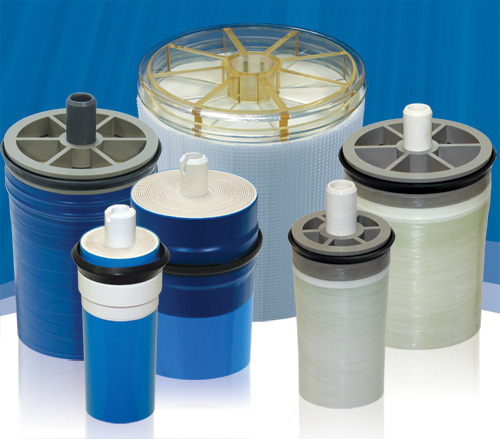RO Membranes Faq

- What is the difference between Thin Film & CTA Membranes?
- Can Thin Film RO membranes tolerate chlorine?
- What is the difference between tap & brackish water membranes?
- What are the differences of different brands of membranes?
- What is the difference between the different flow res membranes?
- What is the difference between dry and wet membranes?
- Proper storage conditions & shelf-life for membranes.
- What is the difference between Thin Film & CTA Membranes?
CTA (Cellulose Triacetate) membrane is a paper by-product membrane bonded to a synthetic layer. CTA membranes are made to allow contact with chlorine in the water. These require a small amount of chlorine in the water source to prevent bacteria from forming on it. CTA membranes have a rejection rate of 85-95%.
TFC (Thin Film Composite) membrane is made of a a synthetic material, and requires chlorine to be removed before the water enters the membrane. Chlorine will cause irreversible damage to a thin film membrane element - for this reason, carbon filters are used as pre-treatment in all residential reverse osmosis systems using TFC membranes. A Thin film membrane has a higher rejection (95-98%) and longer life than the CTA membrane.
[Back To Top] - Can Thin Film RO membranes tolerate chlorine?
Chlorine will oxidize the surface of thin film composite polyamide membranes, causing the membrane to lose its ability to repel or reject salts.
Thin film membranes can tolerate up to 1000 ppm-hours of chlorine. Traces of metals will accelerate oxidation. Therefore chlorine should be removed from the RO feed water.
[Back To Top] - What is the difference between tap & brackish water membranes?
There is no difference in the membrane material. Brackish water membranes have an outer shell of fiberglass whereas Tap water have a tape wrap. The construction allows Brackish water membranes to be operated at higher pressures required to treat brackish water.
[Back To Top] - What are the differences of different brands of membranes?
What are the differences of different types of membranes? Are all membranes of the same type (e.g. TFC) from different manufacturers the same? (example: an oil filter by Toyota is different from that of Mitsubishi).
You are right. These are very similar in construction and performance. Like other products, the main difference is in the reputation and reliability of the manufacturer. However, because there are different manufacturers, membranes do come in several end type configurations depending on the manufacturer. When ordering vessels, you will need to specify what brand of membrane you plan on using so the appropriate end adapters can be built in. When replacing membranes with a different brand, you should check the membrane specifications to make sure the end configuration is compatible for direct replacement.
[Back To Top] - What is the difference between the different flow res membranes?
Question:Why is the performance different in different flow rated residential membranes? (24 gpd, 36 gpd, 100 gpd, etc.) The membranes look the same even the number of times rolled up.
Answer:The useful area of the membrane material is different in the two sizes. They look the same because of the difference in membrane area is made up by other fabrics.
[Back To Top] - What is the difference between dry and wet membranes?
When the thin-film membranes are manufactured they are dry. These dry membranes have an indefinite shelf life, when stored properly. Membranes become wet when they are flushed or tested with water. Once wet, the membranes can not be dried. The wet membranes must be preserved to prevent the growth of micro-organisms on them. This is done usually by using a 1-2% solution of sodium metabisulfite. For more details look for information on storing membranes.
[Back To Top] - Proper storage conditions & shelf-life for membranes.
Membrane Storage
-
Store membranes in a cool area out of direct sunlight. Membrane storage temperature limits are 22°F-113°F (-5.5°C to 45°C)
-
Preserve in a solution of 2% AM-88 Membrane Preservative, and 20% AM-225 Glycerine. This will not prevent freezing below 32°F, but the crystals are soft and the membrane is not damaged.
-
Keep new elements in original packaging.
-
Examine the preservative in preserved elements every 3 months. If not clear, remove and re-preserve. The pH of the preservative should not drop below 3.
-
Storage time for preserved elements is 6 months to 1 year.
-
Storage time for dry (new) elements is unlimited, and these can withstand temperatures below 22°F.
Membrane Shipping
-
Preserve the element in the plastic bag using the recommended procedure. Make sure the plastic bag does not leak and the element is properly identified.
-
Make sure the preservative solution is correctly labeled.
-
Protect the element package from physical damage.
System Shut-Down
-
Clean the membranes in the system using the cleaning procedure.
-
Circulate the preservative solution.
-
Shut down the system and close valves to prevent air entering the system.
-
Check preservative once a month.
[Back To Top] -